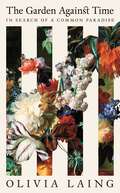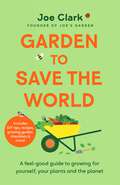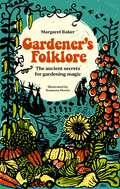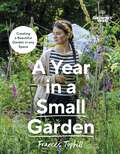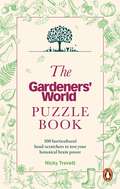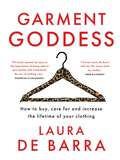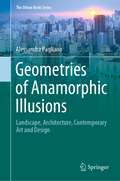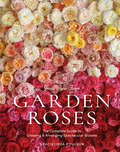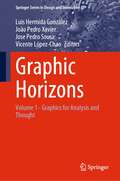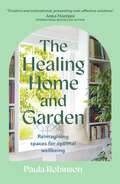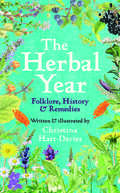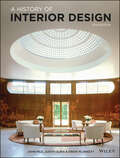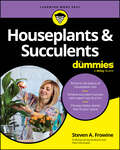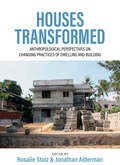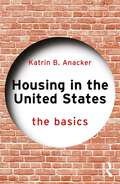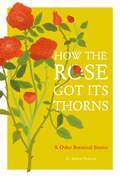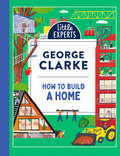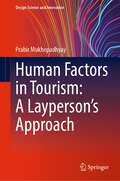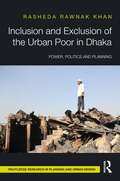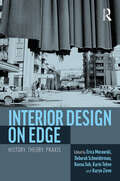- Table View
- List View
The Garden Against Time: In Search of a Common Paradise
by Olivia Laing'What a wonderful book this is. I loved the enchanting and beautifully written story but also the fascinating and thoughtful excursions along the way.' – Nigel Slater‘A garden contains secrets, we all know that: buried elements that might put on strange growth or germinate in unexpected places. The garden that I chose had walls, but like every garden it was interconnected, wide open to the world . . .’In 2020, Olivia Laing began to restore a walled garden in Suffolk, an overgrown Eden of unusual plants. The work drew her into an exhilarating investigation of paradise and its long association with gardens. Moving between real and imagined gardens, from Milton’s Paradise Lost to John Clare’s enclosure elegies, from a wartime sanctuary in Italy to a grotesque aristocratic pleasure ground funded by slavery, Laing interrogates the sometimes shocking cost of making paradise on earth.But the story of the garden doesn’t always enact larger patterns of privilege and exclusion. It’s also a place of rebel outposts and communal dreams. From the improbable queer utopia conjured by Derek Jarman on the beach at Dungeness to the fertile vision of a common Eden propagated by William Morris, new modes of living can and have been attempted amidst the flower beds, experiments that could prove vital in the coming era of climate change.The result is a beautiful and exacting account of the abundant pleasures and possibilities of gardens: not as a place to hide from the world but as a site of encounter and discovery, bee-loud and pollen-laden.
Garden To Save The World: A Feel-Good Guide to Growing for Yourself, Your Plants and the Planet
by Joe ClarkNo matter your space, gardening expert and social media sensation Joe Clark will help you find joy and peace in the natural world.Nature enthusiast Joe Clark is here to help you make the most of the outdoors, whether or not you have a garden of your own. Garden to Save the World covers everything from growing your own food and eating seasonally to keeping vital ecosystems alive by encouraging wildlife and appreciating all nature has to offer.Garden to Save the World showcases just how fantastic the natural world is, both for your physical and mental health. It’s a fun, positive guide to the joys of the natural world as a haven for all. The book is complete with practical takeaways on how to make an urban bee hotel, zero waste tips, going wild, using your garden as a supermarket and more. There are fun facts and surprising stories about what your garden can do for you, your community and the planet. Perfect for any budding or seasoned nature lover.- DIY tips on how to make your garden more sustainable- Growing guides so you can grow your favourite vegetables- Advice on how to avoid food waste with tips on how to store, preserve and ferment food- Delicious recipes to try at home- Checklists throughout the book Joe has a brilliant community of nearly 2 million online, where he shares top tips on his Joesgarden platforms.
Gardener's Folklore: The ancient secrets for gardening magic
by Margaret BakerEver wondered if there's any truth behind planting by the moon? Or why wassailing is still a common folk practice in some parts of the world? In Gardener's Folklore, the record of these practices is unveiled, with plenty of tips and tricks to try in your own 21st century garden for blooming bushes and plentiful potatoes.First published in 1976, Gardener's Folklore collects the little bits of magic and myth to be found in the gardens of Britain and North America. Compiled from letters sent by gardeners to the author Margaret Baker, it unravels and documents the mysterious sayings and scraps of knowledge that are passed down through generations, while exploring the science of the time that backed up - or in some cases, didn't - the claims that were made.This delightfully written book shows just what people have believed and still believe will help their plants to grow. The observance of lunar and astrological conditions when planting, ways of encouraging fruit-bearing and discouraging pests, beliefs about the effects of climate and calendar, spells, the influence for good and bad of certain plants, the links between owners and trees - these are only a few of the aspects of gardening lore that are discussed.Gleaned from the people who grew up with them, they have much to say about our rural origins as well as having, here and there, implications for our future. Capturing the knowledge that old-time gardeners used to have remarkable successes, the ancient secrets of a happy healthy garden are shared for a new generation of green-fingered plant-lovers.
Gardeners’ World: Creating a Beautiful Garden in Any Space
by Frances TophillA Year in a Small Garden follows Frances Tophill as she creates her new garden in a terraced house in Devon. Working in a small space, the book documents her journey to bring life to her garden, including tips and tricks for you to achieve similar results in whatever spaces you have at home.The book is structured around the stages of building her small garden, and branches out to include small community gardens Frances works with, as well as projects to create in small spaces at home - with a focus on growing food and planting in a sustainable, environmentally friendly way.Featuring new photography shot throughout the year, as well as Frances's own journal and garden notebooks, this book will not only give you an insight into Frances's journey creating her first garden - but will help you create a beautiful, productive, garden at home.
The Gardeners' World Puzzle Book
by Gardeners' World Magazine100 horticultural head-scratchers to test your botanical brain powerCan you tell Myosotis from Magnolia? Can you tell your beeches from your birches?Featuring 100 puzzles including crosswords, word searches, anagrams, word wheels and code breakers, The Gardeners’ World Puzzle Book has everything you need to unwind from a long day in the garden while sharpening your mind at the same time.Organised by season and difficulty, this fun and beautiful book offers everything from easy breezy brainteasers to the thorniest of horticultural headscratchers – the perfect companion for any grower!
Garment Goddess: How to buy, care for and increase the lifetime of your clothing
by Laura De BarraWould you like a long-lasting wardrobe filled with garments you love? New or vintage, online or high street – this book will help you buy right to begin with and maintain well for longevity, ensuring that your shopping, storage and laundry habits are enhancing and not hampering the life of your clothing. Delving into such delights as fabric composition and manufacturing techniques, as well as how to assess if garments are right for your wants and needs, Garment Goddess is a new bible for the modern home. In a world of fast fashion and dwindling quality, consumers have the power to influence what happens next. This book will not only help you to buy well, mend well and wear well, it will also help you to contribute positively to an industry impacted by overconsumption.
Geometries of Anamorphic Illusions: Landscape, Architecture, Contemporary Art and Design (The Urban Book Series)
by Alessandra PaglianoThis book intends to focus exclusively on anamorphic experiments in contemporary art and design, leaving an in-depth historical examination of its Baroque season to other studies. Themes, languages and fields of application of anamorphosis in contemporary culture are critically analyzed to make the reader aware of the communicative potentiality of this kind of geometrical technique. The book also has the aim to teach the reader the most appropriate geometric techniques for each of them, in order to achieve the designed illusion. Each typology of anamorphosis is accompanied in this book by contemporary installations, a geometrical explanation by means of 3D models and didactic experiments carried on in collaboration with the students of the Department of Architecture in Naples.
Grace Rose Farm: The Complete Guide to Growing & Arranging Spectacular Blooms
by Gracielinda PoulsonAn inspiration of roses A one-of-a-kind guide to growing, cutting, and arranging the most beautiful roses in the world, Garden Roses belongs in the hands of every flower lover. Created by Gracielinda Poulson, the preeminent rose grower in the country and proprietor of Grace Rose Farm, each page of this glorious book steeps the reader in the iconic mystique of the rose: Its breathtaking beauty, in hundreds of photographs. Its secrets, in the incredible breadth of information on the varieties best suited for cutting and how to raise them to thrive in the garden or a container, in almost any climate zone. And its unique presence in our lives, in all the ways to style and display roses, from a simple vaseful to more elaborate tablescapes and floral arches, truly elevating the flower that more than any other has captured our imaginations and delighted our eyes.
Graphic Horizons: Volume 1 - Graphics for Analysis and Thought (Springer Series in Design and Innovation #42)
by Luis Hermida González João Pedro Xavier Jose Pedro Sousa Vicente López-ChaoThis book reports on several advances in architectural graphics, with a special emphasis on education, training, and research. It gathers a selection of contributions to the 20th International Congress of Architectural Graphic Expression, EGA 2024, held on May 27-29, 2024, in Porto, Portugal, with the motto: "Graphic Horizons". This is the first of a 3-volume set.
The Healing Home and Garden: Reimagining spaces for optimal wellbeing
by Paula RobinsonAre you tired of formulaic interiors and following trends? Do you long for a home that expresses who you truly are, that's a sanctuary from our 24/7 lifestyles dominated by technology?The Healing Home & Garden will help you to:- Take an objective look at your home - Examine whether it's supporting your mental and physical wellbeing - Identify how it may be perpetuating unhealthy habits like: working all hours, eating on the run, poor sleep and spending too much time indoors - Tap into your intuition to create a healing environment that will ultimately make you happier, less stressed and healthier - Reconnect with the restorative power of natureThe Healing Home & Garden is for everyone - no matter your budget, whether you rent or own, live in a bedsit or a mansion. No major building works are involved, just a call to follow your own intuition and create the home that's right for you - not the style police! This book is full of budget tips for rethinking your living space, creative suggestions for re-purposing furniture and objects, and extensive product and book recommendations."Paula Robinson is at the leading edge of new systems of awareness about the spaces we inhabit... a treasure trove of practical, step-by-step guidance"Jean Haner, author of Clear Home Clear Heart: Learn to Clear the Energy of People and Places
The Herbal Year: Folklore, History and Remedies
by Christina Hart-DaviesAn enchanting, beautifully illustrated guide to seasonal plants—showing the long history of herbal remedies and their uses today“[A] charming almanac. . . . Hart-Davies, a writer and botanical illustrator whose watercolors enliven her book, . . . offers a lively combination of folk history and modern science; they overlap in intriguing ways.”—Priscilla M. Jensen, Wall Street Journal From sweet violets in spring to rosemary in winter, via marigolds, sage, elderberries, and hops, every season has its own bounty of herbs and plants. Christina Hart-Davies presents a delightful guide to common plants as they appear throughout the year. Drawing on writers, storytellers, and poets from across the centuries, she examines the long history of herbal remedies. She shows how plants have been used for healing and unearths the stories and beliefs that surround them—including simple recipes for use at home. Fully illustrated with exquisitely detailed watercolours, this is an inspirational guide to exploring our age-old relationship with plants. Readers will discover the hidden secrets of the plants that surround us and, through this, will be able to reconnect with our place in nature. We have relied on plants throughout our history. We still do, and, with luck, we always will.
A History of Interior Design
by John Pile Judith Gura Drew PlunkettA History of Interior Design tells the story of 6,000 years of domestic and public space. It’s an essential resource for students, professionals, and anyone interested in interior design, the decorative arts, architecture, and art history. It explores a broad range of styles and movements, weaving together a fascinating narrative from cave dwellings and temple architecture, through Gothic cathedrals and Islamic palaces, to modern skyscrapers and the retail spaces of the 21st-century. This fully updated fifth edition includes: More on the contributions of women designers and architects Additional coverage of furniture, product design, and decoration Numerous new examples of diverse modern styles from around the world Over 700 images, more than 300 of which are new or color replacements for black and white photos An extra final chapter focusing on the influence of the latest technology and current thinking on the importance of conservation and ethical sourcing
A History of Interior Design
by John Pile Judith Gura Drew PlunkettA History of Interior Design tells the story of 6,000 years of domestic and public space. It’s an essential resource for students, professionals, and anyone interested in interior design, the decorative arts, architecture, and art history. It explores a broad range of styles and movements, weaving together a fascinating narrative from cave dwellings and temple architecture, through Gothic cathedrals and Islamic palaces, to modern skyscrapers and the retail spaces of the 21st-century. This fully updated fifth edition includes: More on the contributions of women designers and architects Additional coverage of furniture, product design, and decoration Numerous new examples of diverse modern styles from around the world Over 700 images, more than 300 of which are new or color replacements for black and white photos An extra final chapter focusing on the influence of the latest technology and current thinking on the importance of conservation and ethical sourcing
Houseplants & Succulents For Dummies
by Steven A. FrowineBecome the best plant parent you can be Houseplant hysteria is here to stay. For new and seasoned plant owners alike, Houseplants & Succulents For Dummies is the ideal resource on plant care, growing cycles, unique plant varieties, and all the essentials you need to know about your rooted friends. Ensure that your sprouts grow and thrive, with tons of tips and answers to all your questions. Are they getting enough light? Are you overwatering? Why are the leaves turning yellow? This fun Dummies guide teaches you to find the right plants for your personal plant care style, identify common varieties, choose the right potting soil, and pick the perfect little nook for your leaf baby. You’ll also learn how to rescue your plants when pests and diseases strike, and even how to use plants as part of a stylish home décor approach. Get growing! Learn about the different types of plants and choose the ones that will work for you Figure out how to keep your plants happy—and what to do about it if they’re not Determine how often to water plants, what type of soil they need, and how much light Improve your mental and respiratory health by filling your home with plantsGrab this handy book if you’re new to the houseplant craze and want a user-friendly, comprehensive guide on plant care. Intermediate and advanced plant parents will also love this handy reference with info on the latest plant trends and new varieties.
Houseplants & Succulents For Dummies
by Steven A. FrowineBecome the best plant parent you can be Houseplant hysteria is here to stay. For new and seasoned plant owners alike, Houseplants & Succulents For Dummies is the ideal resource on plant care, growing cycles, unique plant varieties, and all the essentials you need to know about your rooted friends. Ensure that your sprouts grow and thrive, with tons of tips and answers to all your questions. Are they getting enough light? Are you overwatering? Why are the leaves turning yellow? This fun Dummies guide teaches you to find the right plants for your personal plant care style, identify common varieties, choose the right potting soil, and pick the perfect little nook for your leaf baby. You’ll also learn how to rescue your plants when pests and diseases strike, and even how to use plants as part of a stylish home décor approach. Get growing! Learn about the different types of plants and choose the ones that will work for you Figure out how to keep your plants happy—and what to do about it if they’re not Determine how often to water plants, what type of soil they need, and how much light Improve your mental and respiratory health by filling your home with plantsGrab this handy book if you’re new to the houseplant craze and want a user-friendly, comprehensive guide on plant care. Intermediate and advanced plant parents will also love this handy reference with info on the latest plant trends and new varieties.
Houses Transformed: Anthropological Perspectives on Changing Practices of Dwelling and Building
by Jonathan Alderman Rosalie StolzOver the decades, there has been a world-wide transformation of so-called ‘vernacular houses’. Based on ethnographic accounts from different regions, Houses Transformed investigates the changing practices of building houses in a transnational context. It explores the intersection of house biographies and social change, the politics of housing design, the social fabrication of aspirational houses, the domestication of concrete and the intersection of materiality and ontology as well as the rhetoric of the vernacular. The volume provides new anthropological pathways to understanding the dynamics of dwelling in the 21st century.
Housing in the United States: The Basics (The Basics)
by Katrin B. AnackerHousing matters to people, be they owner, renter, housing provider, homeless individual, housing professional, or policymaker. Housing in the United States: The Basics offers an accessible introduction to key concepts and issues in housing—and a concise overview of the programs that affect housing choices, affordability, and access in the United States today. Part I covers the fundamentals of housing: households, housing units, and neighborhoods; housing as basic need vs. human right; supply and demand; construction, rehabilitation, and renovation; and demographic, socioeconomic, and cultural trends. Part II focuses on housing policy and its evolution from the early 20th century, through the Great Recession to the present day; policies related to owner- and renter-occupied housing; tax policies and expenditures; place- and people-based programs; and shortages of affordable housing.Written in a clear and engaging style, this guide allows readers to quickly grasp the complex range of policies, programs, and factors that shape the housing landscape. Essential reading for students, community advocates, homebuyers/renters, and professionals with an interest in housing, it also serves as an ideal text for introductory courses in urban planning, urban studies, sociology, public administration, architecture, and real estate.This book provides a valuable and practical foundation for informed housing discussions at the kitchen table, in the classroom, at work, or on Capitol Hill.
Housing in the United States: The Basics (The Basics)
by Katrin B. AnackerHousing matters to people, be they owner, renter, housing provider, homeless individual, housing professional, or policymaker. Housing in the United States: The Basics offers an accessible introduction to key concepts and issues in housing—and a concise overview of the programs that affect housing choices, affordability, and access in the United States today. Part I covers the fundamentals of housing: households, housing units, and neighborhoods; housing as basic need vs. human right; supply and demand; construction, rehabilitation, and renovation; and demographic, socioeconomic, and cultural trends. Part II focuses on housing policy and its evolution from the early 20th century, through the Great Recession to the present day; policies related to owner- and renter-occupied housing; tax policies and expenditures; place- and people-based programs; and shortages of affordable housing.Written in a clear and engaging style, this guide allows readers to quickly grasp the complex range of policies, programs, and factors that shape the housing landscape. Essential reading for students, community advocates, homebuyers/renters, and professionals with an interest in housing, it also serves as an ideal text for introductory courses in urban planning, urban studies, sociology, public administration, architecture, and real estate.This book provides a valuable and practical foundation for informed housing discussions at the kitchen table, in the classroom, at work, or on Capitol Hill.
How the Rose Got Its Thorns: And Other Botanical Stories
by Dr Andrew OrmerodHave you ever wondered why the rose has thorns and other flowers don't; why the daffodil is the colour it is; or why some plants have shiny leaves and others matt?How The Rose Got its Thorns reveals the inner workings of our favourite flowers and trees. Designed to help gardeners, both novice and experienced, better understand how plants grow, the book is easy to navigate - it is divided into 50 chapters, each one a story.Accompanied by specially commissioned colour illustrations, each chapter explains the science behind how plants work and the extraordinary processes they have evolved: such as protecting themselves from predators using chemicals; attracting pollinators using scent, shape and colour; growing in low or high temperatures; their relationship with the wind; the size and pattern of their leaves; the distribution of their seeds and survival strategies; their relationship with insects; how they allocate their resources; and how they retain water efficiently.This delightful and intriguing book offers readers an accessible way to better understand how our plants evolved into the species of today.
How to Build a Home (Little Experts #Book 5)
by George ClarkeGet designing and building with architect and TV presenter GEORGE CLARKE. From marvellous materials to future tech – discover the stories behind our homes.
Human Factors in Tourism: A Layperson's Approach (Design Science and Innovation)
by Prabir MukhopadhyayThe textbook covers the application of human factors in different facets of tourism and hospitality industry. It talks about appropriate ambience creation for guests, so they can enjoy their stay. This book enumerates different human factors aspects of dealing with tourists, conducting guided tours, or ensuring that tourists are completely satisfied from the tour in detail but in a layperson’s language. This book discusses details of the application of human factors in the tourism sector. This book aims to fill the gap between the literature available on tourism that deals with people and human factors that deals with the interaction among people, space, and products. This book aids the students and instructors in understanding and teaching different human factors issues in this sector. Further, this book will help professionals in the industry in providing quality services to their clients.
Inclusion and Exclusion of the Urban Poor in Dhaka: Power, Politics, and Planning
by Rasheda Rawnak KhanInclusion and Exclusion of the Urban Poor in Dhaka explores how the inhabitants of poor neighborhoods in Dhaka, Bangladesh, gain inclusion in the city at the face of exclusion. The book considers how the people of poor neighborhoods encounter the exclusionary behavior of city development, and how their inclusionary attempts have influenced the urban design. The book is presented in two parts: first, it explains how people in poor neighborhoods face exclusion because of the imbalance of power and politics. Second, it demonstrates how the existing exclusion of urban poor is affecting their strategies to gain access to urban services through people’s power and politics. Focusing on the transdisciplinary field of urban anthropology, the chapters uncover the urban forces, policies and actions that facilitate urban politics. It also investigates the people who live in poor neighborhoods, who in the face of exclusion, have included themselves in urban development planning and design by employing diverse strategies against those forces in the urban politics, e.g., accepting dominance, bargaining, or having control over their lives. This book will recontextualize an ethnographic inquiry into the exclusion and inclusion of the people within city development design, plans and innovations in applications of anthropological theory and methodology. This book will encourage the reader to understand the politics of state’s development projects and plans, and furthermore instigate the city government, planners and policymakers to focus on the people's political power and agency that enables them to achieve inclusion. It will therefore be of interest to researchers and students of urban planning and development, urban geography, and urban anthropology, as well as planning professionals and policymakers.
Inclusion and Exclusion of the Urban Poor in Dhaka: Power, Politics, and Planning
by Rasheda Rawnak KhanInclusion and Exclusion of the Urban Poor in Dhaka explores how the inhabitants of poor neighborhoods in Dhaka, Bangladesh, gain inclusion in the city at the face of exclusion. The book considers how the people of poor neighborhoods encounter the exclusionary behavior of city development, and how their inclusionary attempts have influenced the urban design. The book is presented in two parts: first, it explains how people in poor neighborhoods face exclusion because of the imbalance of power and politics. Second, it demonstrates how the existing exclusion of urban poor is affecting their strategies to gain access to urban services through people’s power and politics. Focusing on the transdisciplinary field of urban anthropology, the chapters uncover the urban forces, policies and actions that facilitate urban politics. It also investigates the people who live in poor neighborhoods, who in the face of exclusion, have included themselves in urban development planning and design by employing diverse strategies against those forces in the urban politics, e.g., accepting dominance, bargaining, or having control over their lives. This book will recontextualize an ethnographic inquiry into the exclusion and inclusion of the people within city development design, plans and innovations in applications of anthropological theory and methodology. This book will encourage the reader to understand the politics of state’s development projects and plans, and furthermore instigate the city government, planners and policymakers to focus on the people's political power and agency that enables them to achieve inclusion. It will therefore be of interest to researchers and students of urban planning and development, urban geography, and urban anthropology, as well as planning professionals and policymakers.
Interior Design on Edge: History, Theory, Praxis
Interior Design on Edge explores ways that interiors both constitute and upset our edges, whether physical, conceptual or psychological, imagined, implied, necessary or discriminatory.The essays in this volume explore these questions in history, theory, and praxis through a focus on different periods, cultures, and places. Interior Design on Edge showcases new scholarship that expands and contests traditional relationships between architecture, interiors, and the people that use and design them, provoking readers to consider the interior differently, moving beyond its traditional, architectural definition. Focusing on the concept of interiority considered in a wider sense, it draws on interdisciplinary modes of investigation and analysis and reflects the latest theoretical developments in the fields of interior design history and practice.With new research from both established and emerging authors, this volume will make a valuable contribution to the fields of Interior Design, Architecture, Art and Design History, Cultural History, Visual Culture Studies, and Urban Studies.
Interior Design on Edge: History, Theory, Praxis
by Erica Morawski Deborah Schneiderman Keena Suh Karin Tehve Karyn ZieveInterior Design on Edge explores ways that interiors both constitute and upset our edges, whether physical, conceptual or psychological, imagined, implied, necessary or discriminatory.The essays in this volume explore these questions in history, theory, and praxis through a focus on different periods, cultures, and places. Interior Design on Edge showcases new scholarship that expands and contests traditional relationships between architecture, interiors, and the people that use and design them, provoking readers to consider the interior differently, moving beyond its traditional, architectural definition. Focusing on the concept of interiority considered in a wider sense, it draws on interdisciplinary modes of investigation and analysis and reflects the latest theoretical developments in the fields of interior design history and practice.With new research from both established and emerging authors, this volume will make a valuable contribution to the fields of Interior Design, Architecture, Art and Design History, Cultural History, Visual Culture Studies, and Urban Studies.
